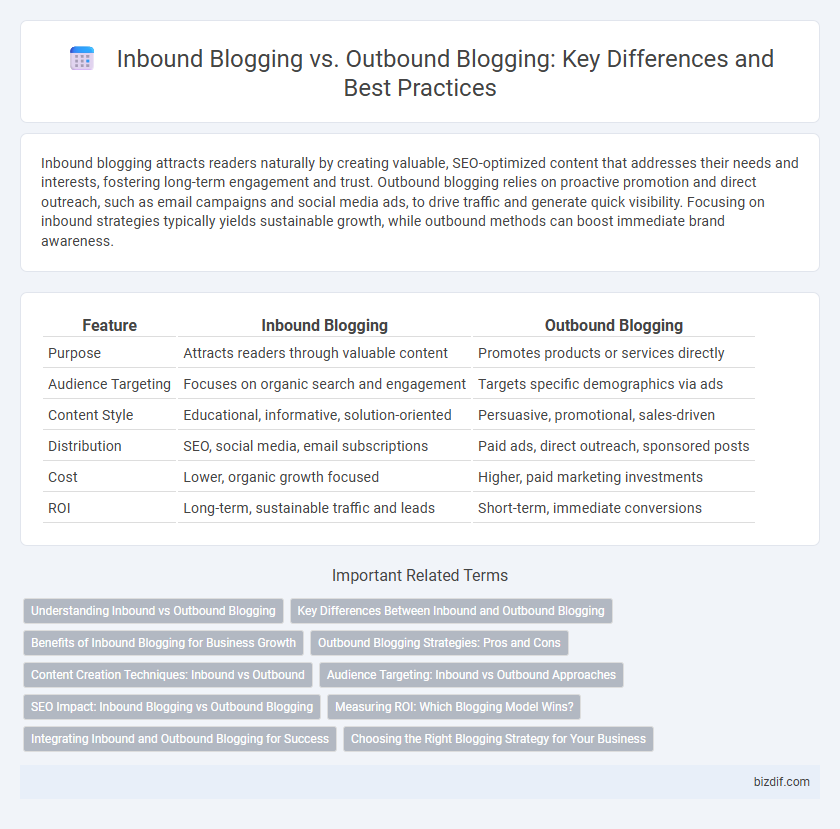Inbound blogging attracts readers naturally by creating valuable, SEO-optimized content that addresses their needs and interests, fostering long-term engagement and trust. Outbound blogging relies on proactive promotion and direct outreach, such as email campaigns and social media ads, to drive traffic and generate quick visibility. Focusing on inbound strategies typically yields sustainable growth, while outbound methods can boost immediate brand awareness.
Table of Comparison
| Feature | Inbound Blogging | Outbound Blogging |
|---|---|---|
| Purpose | Attracts readers through valuable content | Promotes products or services directly |
| Audience Targeting | Focuses on organic search and engagement | Targets specific demographics via ads |
| Content Style | Educational, informative, solution-oriented | Persuasive, promotional, sales-driven |
| Distribution | SEO, social media, email subscriptions | Paid ads, direct outreach, sponsored posts |
| Cost | Lower, organic growth focused | Higher, paid marketing investments |
| ROI | Long-term, sustainable traffic and leads | Short-term, immediate conversions |
Understanding Inbound vs Outbound Blogging
Inbound blogging focuses on attracting readers through valuable, engaging content optimized for search engines, leading to organic traffic and long-term audience growth. Outbound blogging involves actively distributing content via paid promotions, social media ads, or email campaigns to reach broader or targeted audiences quickly. Understanding the strategic balance between inbound and outbound blogging helps marketers maximize content visibility and drive consistent website engagement.
Key Differences Between Inbound and Outbound Blogging
Inbound blogging focuses on creating valuable, SEO-optimized content that attracts and engages readers organically through search engines and social media, driving long-term traffic and building trust. Outbound blogging relies on promotional tactics such as paid ads, guest posting, and direct outreach to distribute content and quickly reach a targeted audience. Key differences include the inbound strategy's emphasis on content quality and user engagement versus outbound's focus on amplification and immediate visibility.
Benefits of Inbound Blogging for Business Growth
Inbound blogging drives organic traffic through valuable, audience-focused content that builds trust and long-term relationships with potential customers. It enhances search engine visibility, increasing brand awareness and attracting qualified leads without high advertising costs. Consistent inbound blogging nurtures customer engagement and supports sustainable business growth by positioning the company as an industry authority.
Outbound Blogging Strategies: Pros and Cons
Outbound blogging strategies involve actively reaching out to external audiences through guest posts, influencer collaborations, and paid promotions, enhancing brand visibility beyond organic reach. These tactics can generate immediate traffic spikes and diverse backlinks but often require higher investment, both in terms of time and budget, compared to inbound methods. The downside includes potential audience resistance to overt marketing and lower long-term engagement if content lacks relevance or authenticity.
Content Creation Techniques: Inbound vs Outbound
Inbound blogging emphasizes creating valuable, relevant content tailored to attract and engage a targeted audience through SEO, storytelling, and educational resources. Outbound blogging focuses on promotional content designed to reach broader audiences via paid ads, guest posts, and sponsorship placements. Effective inbound strategies prioritize organic growth and trust-building, while outbound tactics concentrate on immediate visibility and traffic generation.
Audience Targeting: Inbound vs Outbound Approaches
Inbound blogging focuses on attracting a well-defined audience by creating valuable, search-optimized content that addresses their specific interests and pain points, thereby driving organic traffic and fostering long-term engagement. Outbound blogging targets a broader, less specific audience through promotional posts and paid distribution methods designed to generate immediate awareness and quick responses. Understanding the distinct audience targeting strategies of inbound and outbound blogging enables marketers to align content efforts with desired engagement outcomes and conversion goals.
SEO Impact: Inbound Blogging vs Outbound Blogging
Inbound blogging enhances SEO impact by attracting organic traffic through targeted content that aligns with user search intent, increasing dwell time and reducing bounce rates. Outbound blogging focuses on generating leads by promoting products or services directly, which can result in higher immediate conversions but may limit long-term SEO benefits due to less keyword relevance and engagement. Effective SEO strategies prioritize inbound blogging to build authority and improve search engine rankings over time.
Measuring ROI: Which Blogging Model Wins?
Measuring ROI in inbound blogging relies on tracking metrics like organic traffic growth, lead generation from content downloads, and conversion rates attributed to SEO efforts. Outbound blogging's ROI evaluation often focuses on immediate audience reach, engagement through sponsored posts, and the direct impact of paid amplification. Inbound blogging generally wins in long-term ROI due to sustained traffic and higher quality lead generation, while outbound blogging offers faster but less sustainable results.
Integrating Inbound and Outbound Blogging for Success
Integrating inbound and outbound blogging strategies maximizes audience reach and engagement by combining SEO-driven content with proactive promotion efforts. Inbound blogging attracts targeted organic traffic through keyword-rich articles and valuable information, while outbound blogging amplifies content visibility via social media, email newsletters, and guest posts. This holistic approach enhances brand authority, drives consistent website traffic, and accelerates lead generation for sustainable blogging success.
Choosing the Right Blogging Strategy for Your Business
Inbound blogging focuses on attracting targeted visitors through valuable, SEO-optimized content that addresses audience needs, increasing organic traffic and engagement. Outbound blogging relies on proactive outreach and promotional tactics, such as guest posting and content syndication, to expand reach and accelerate lead generation. Selecting the right blogging strategy depends on your business goals, audience behavior, and available resources to maximize ROI and brand visibility.
Inbound Blogging vs Outbound Blogging Infographic

 bizdif.com
bizdif.com